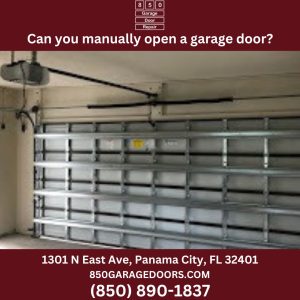
Understanding How Garage Doors Work
The role of the garage door opener
A modern opener is a motorized device that moves the door along a track using a drive system such as chain, belt, or screw. The opener does not carry all the weight. Torsion or extension springs provide counterbalance so the door feels lighter than it actually is. When everything is tuned correctly, the door should stay in place when lifted halfway, which indicates proper spring tension and good balance.
What happens during a power outage
When the power goes out, the opener will not respond to the wall button or remote. To prevent you from being locked out, every opener includes a manual release that disconnects the trolley from the door, allowing you to lift it by hand. In storm prone areas of Florida, a quick manual release can be the difference between getting your vehicle inside before a squall line arrives and leaving it exposed to wind driven rain.
Safety features built into garage doors
Openers include protections such as an automatic reverse if the door meets resistance and photo eye sensors near the floor that stop the door when the beam is broken. These features protect people and pets during normal operation. Keep in mind that once you release the opener for manual use, those electronic features are bypassed, so your judgment and careful movement become the safety system.
Yes, You Can Open a Garage Door Manually
When you might need to do it
You may need manual operation during a blackout, when a remote battery is dead, or when the opener motor has failed. You might also use manual mode to test door balance or to move the door while troubleshooting a sensor issue.
Common scenarios power failure, motor failure, remote issues
- Power failure: After a thunderstorm the opener is unresponsive. Manual release allows you to lift the door to get in or out.
- Motor failure: An older unit may hum without moving the chain or belt. Manual lifting keeps you mobile while you plan a repair.
- Remote issues: A wall button may still work, but a dead remote or a misprogrammed keypad can force manual operation while you reprogram.
Precautions before attempting
- Make sure the door is fully closed before pulling the release. Releasing when the door is up can cause it to drop quickly if springs or cables are compromised.
- Remove bystanders from the area, especially children and pets.
- Use steady force and keep fingers clear of joints and track edges.
Step by Step Guide to Manually Opening a Garage Door
Locate the emergency release cord
Identifying the red cord or handle
Look for a red cord hanging from the opener trolley that rides along the ceiling rail. The color and location are standardized so you can find it even in low light. If you keep a flashlight near the entry door to the garage, this is a good moment to use it.
Pulling the release to disconnect the opener
What to expect after pulling the cord
Pull the cord straight down to disengage the trolley from the carriage. You will feel or hear a click as the mechanism releases. The door is now free from the opener and can move by hand. Some models require you to pull the cord and then move the door slightly to complete the disconnect. This is normal.
Lifting the door safely
Using both hands and proper stance
Stand facing the door with feet shoulder width apart. Place both hands at a comfortable height on the door sections. Lift smoothly without jerking. If the springs are balanced, the door should rise with moderate effort. If it feels extremely heavy, stop and call a professional, since that may point to a broken spring, a frayed cable, or a roller jam.
Securing the door once open
Preventing it from sliding back down
Raise the door fully until it stops against the track curving overhead. If you need to stop with the door partway open, use a locking pliers on the track just below the bottom roller to keep it from rolling down. This is a temporary measure for safety while you move a vehicle or gather supplies.
| Situation | Action during manual operation |
|---|---|
| Power is out after a summer storm | Pull release, lift door smoothly, secure in the fully open position |
| Remote will not respond | Confirm wall button function, replace remote battery, use manual release if needed |
| Door feels too heavy to lift | Stop and request service since a spring or cable may be compromised |
| Door is stuck partway | Inspect tracks for debris, do not force, set a locking pliers below the roller if needed for stability |
| High wind or driving rain expected | Manually close and lock the door to protect the opening and contents |
- Keep a small flashlight near the interior entry door for nighttime releases.
- Teach every licensed driver in the home how to find and use the release.
- Check the balance of the door twice a year as part of seasonal maintenance.
- Store a spare remote battery in a kitchen drawer or tool kit.
- After any storm, scan the tracks and hardware for salt air corrosion common along the Gulf Coast.
Safety Tips for Manual Operation
Checking the springs and cables before lifting
Look at the torsion spring above the door or the extension springs along the tracks. A visible gap in a torsion spring or a hanging cable is a stop sign. Do not attempt to lift a door that shows these defects, since the full weight can come down suddenly. In coastal Florida, metal parts live in a salty and humid environment, which accelerates wear. A quick visual check every few months can prevent a dangerous surprise.
Avoiding injuries while handling heavy doors
- Lift with your legs and keep your back in a neutral position.
- Keep your grip centered to avoid twisting the sections.
- Wear closed toe shoes so a sudden movement does not catch your foot.
Keeping children and pets away during manual use
Ask family members to stand clear until the door is either fully open or fully closed. Do not allow anyone to duck under a moving door. Manual mode removes the eyes and logic of the opener, so patience and clear communication are essential.
What to Do If the Door Will not Open Manually
Possible mechanical issues
If you have pulled the release and the door still will not budge, there may be a broken spring, a bent track, a failed roller, or a seized bearing in the pulley system. Sometimes a storm pushes debris into the track or knocks a photo eye bracket out of alignment, which can create friction or prevent the opener from releasing cleanly.
When to call a professional repair service
Springs are under high tension and should only be handled by a trained technician. If the door is crooked, extremely heavy, or jerks as you attempt to lift it, stop and request help. A professional will safely secure the door, replace worn parts, and reset balance so that manual operation is easy again. Timely service prevents the kind of cascading failures that can follow a small part failure, such as a cable popping off the drum and bending the track.
Reconnecting the Garage Door Opener
How to reattach the emergency release
With the door closed, pull the release cord toward the opener to reengage the trolley latch. On many models you can simply press the wall button and the opener will reconnect automatically as it begins to move. If your model requires manual reengagement, slide the door a few inches along the rail until the latch clicks into place.
Testing the opener after reconnection
Press the wall button and observe a full open and close cycle. Watch for smooth movement, no rubbing, and no unusual sounds. Confirm that the photo eyes stop the door when you pass an object through the beam. If the door hesitates or reverses unexpectedly, check the track for obstructions and verify that the springs are balanced. If problems persist, schedule a professional inspection.
Preventing Future Problems
Regular maintenance of the opener system
Twice a year, especially before hurricane season and before the winter holidays, plan a quick inspection. Tighten visible fasteners that are loose, check the mounting of the opener to the ceiling structure, and verify that the safety release moves freely. A few minutes with a socket set and a visual scan can save time when you need manual access during a surprise outage.
Lubricating tracks, rollers, and springs
Use a garage specific lubricant on rollers, hinges, and the opener chain if your unit uses one. Avoid applying grease to the track itself since that can attract grit and cause binding. In coastal regions the combination of salt and humidity can leave parts dry and noisy, so a light application a few times a year keeps things quiet and smooth.
Considering a backup battery for your garage door opener
Many openers accept an add on battery that can power several cycles during an outage. This feature is useful during summer storms and brief grid interruptions that are common in Florida. When the battery takes over, you can use the door normally without manual release, which maintains the function of the safety sensors and lights.
Final Thoughts
Manual operation is a useful backup
Knowing how to open a garage door by hand gives you control during outages and equipment failures. The steps are straightforward, and with a little practice you can perform them quickly and safely.
Professional inspection ensures long term safety
If the door feels heavy, looks crooked, or resists movement, stop and bring in a trained technician. A balanced and well maintained door is safer, quieter, and easier to operate whether you are using the opener or lifting by hand.
Conclusion
To recap, you can operate a garage door manually by pulling the emergency release, lifting with steady force, and securing the door before moving through the opening. Use the safety checks in this guide, and if anything seems wrong, request service before continuing. When you want expert help in the Florida Panhandle, the team at 850 Garage Doors is ready to inspect, repair, and maintain your system. For more about services and helpful tips, visit the website for 850 Garage Doors at 850garagedoors dot com.


